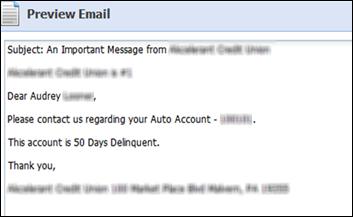The Emails page allows administrators to manage email templates within the Framework. The emails listed on the System Management > Communication > Emails page can be incorporated into Send Email workflow steps by administrators and run by users when working persons/accounts.

The following columns display within the grid:
| Column Name | Description |
| Name | Displays the name of the email template. |
| Description | Displays a description of the email template. |
| Last Modified | Denotes when the last modification on the email was made. |
| Modified By | Denotes who made the last modification on the email. |
From the Emails page, administrators can create new email templates, copy existing templates, edit existing templates and delete templates.
Email Attributes
All emails share common attributes that are defined while creating, copying or editing email templates.
General
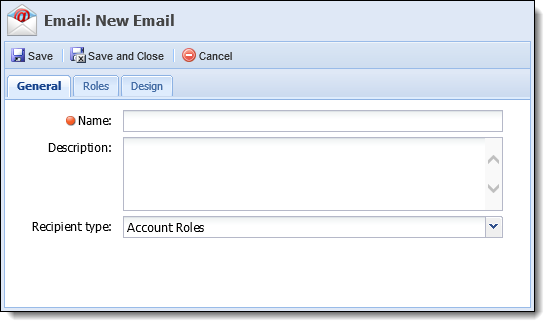
The following general attributes are located within the General tab:
| Attribute | Description | ||
| Name | Enter a name for the email template. This appears when incorporating into a Send Email workflow step. This is a required field. | ||
| Description | If desired, enter a description to provide more information for the email template. | ||
| Recipient Type |
Select the recipient type from the Recipient Type drop-down. The recipient type that is selected displays in the “TO” box on the Roles tab. The Recipient type that is not selected displays in the “CC” box on the Roles tab. The recipient type selected also displays in this section.
For example, Account Roles is selected as the recipient type in the Recipient Type drop-down. All of the account roles display in the “TO” box. By default, Contact Roles and Account roles display in the “CC” box. Account Roles: Account roles are configured in System Management > Role Types. Contact Roles: Contact roles are configured in System Management > Field Configurations > System Lookups tab.
|
Roles
Role attributes are used to assign the roles that receive the email. The Recipient Type option that is selected on the General tab reflects what is displayed in the “TO” recipients section. The “CC” section displays both the Recipient Type defined and the type not selected.
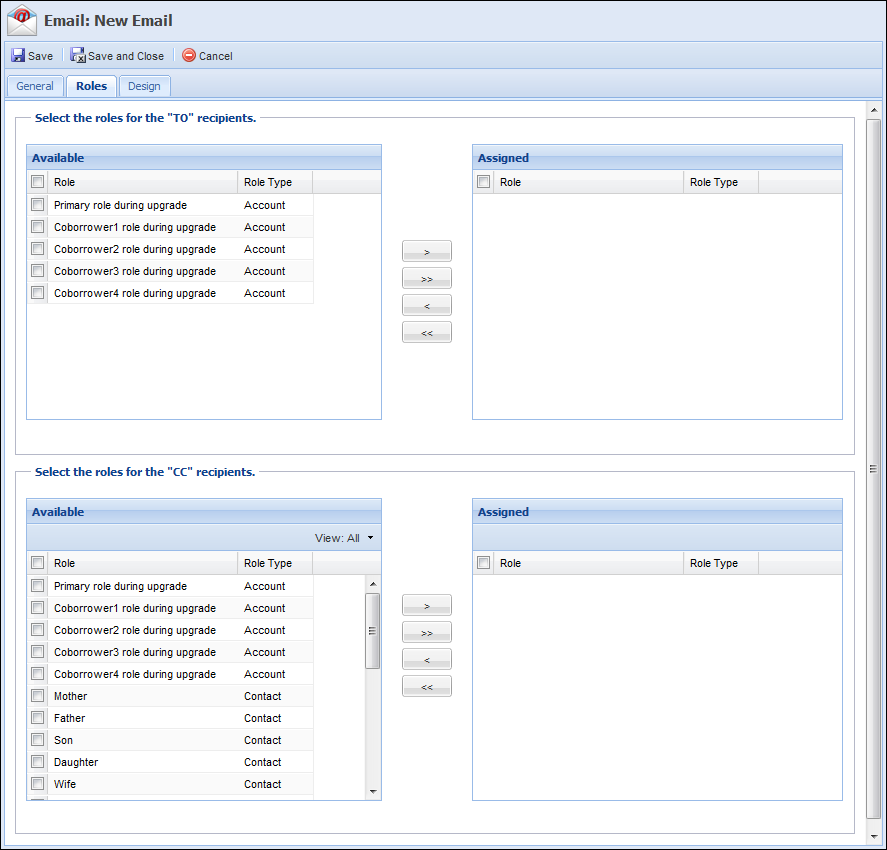
The following role attributes are located within the Roles tab:
| Attribute | Description |
| Assign To recipients | Select roles from the Available list and move them to the Assigned list in the “TO” section to assign the primary recipients of the email. |
| Assign CC recipients | Select roles from the Available list and move them to the Assigned list in the “CC” section to assign secondary recipients of the email that are carbon copied on the email when sent. |
 |
If Administrator and Primary are assigned as recipients of the email in the “TO” section, and the same person has both of these roles on the account, the person receives one email. If Primary was assigned to the “CC” section, the person still receives one email with all of the information in it. |
Design
Design attributes are located within the Design tab.
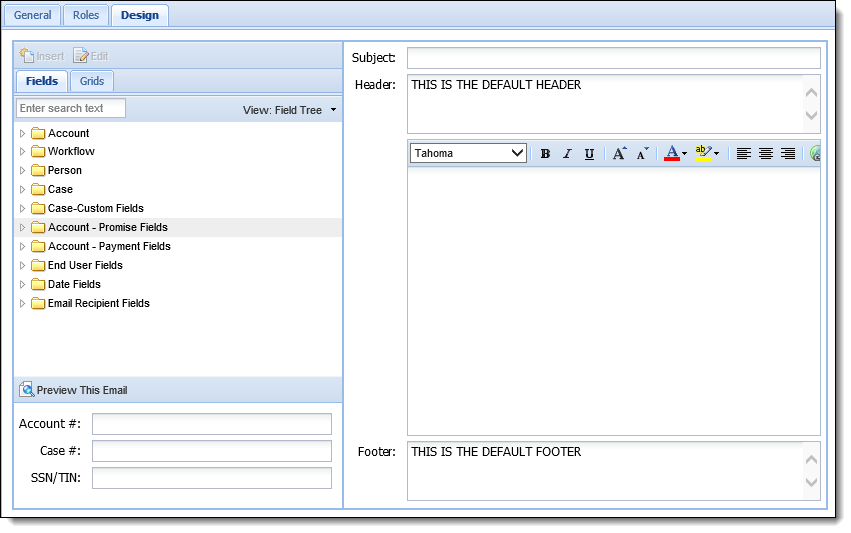
 |
Administrators can set default headers and footers to appear in emails in System Management > Solution > Collection > Email Settings tab. If a header and/or footer is set within the Design tab, it automatically overwrites the default header and footer set by the administrator. |
The left panel of the design tab allows administrators to customize the content contained in the email text section and to preview the email. The top portion of this section contains a Fields tab and a Grids tab.
The Fields tab displays a list of all available fields in the Framework to be used in an email.
| Folder Name | Description | ||
| Account |
Contains all fields associated to the account. The Account folder contains the Primary and Secondary folders. Select fields from these folders if more than one person is being added to the email.
|
||
| Workflow | Contains all fields customized in the Configure Fields tab when building a workflow. | ||
| Person |
Contains all fields associated to the person.
|
||
| Case | Contains fields that are associated to a case. | ||
| Case-Custom Fields | Contains custom fields associated to a case. | ||
| Account - Promise Fields |
Contains fields relative to promise amounts, such as First Promise amount, last promise amount, etc.
|
||
| Account - Payment Fields | Contains fields associated to payments such as payment amount, payment date, transfer source account and transfer destination account. | ||
| End User Fields | Contains all fields that can be used in relation to the user. Use these fields to sign an email with institutions employees contact information. | ||
| Date Fields | Contains Current Date Fields. These are used when the current date or a current day plus a designated amount of days date range needs to be added. | ||
| Email Recipient Fields | These are used to populate the Contacts information. This folder contains two fields: Recipient First Name and Recipient Last Name. |
The Grids tab displays the following grids available to use in an email:
 |
Only one grid can be on an email at a time. Some fields displayed in these grids are not available in the field tree. |
| Grid Name | Description |
| DQ Fields for Letter |
This grid contains account related delinquency information, such as Balance, DQ Amount, Due Date, etc. The following fields are available in this grid:
|
| Vehicle Fields for Letter |
This grid contains vehicle collateral information such as Make, Model, VIN, etc.
The Framework supports multiple pieces of Collateral. This allows the institution to place multiple collateral in an email within a grid. These fields are not available in the field tree. The following fields are available in this grid:
|
| Real Estate Fields for Letter |
This grid contains real estate fields such as address, description, Parcel Number and Property type description. The following fields are available in this grid:
|
| Promise to Pay Fields for Letter |
This grid provides pertinent information regarding a customer's promise to pay information. This grid contains the following fields:
|
| Most Recent Credit Risk Factors |
This grid displays any credit report risk factors associated to a person when a credit report is ran. This grid contains the following field:
|

Double-clicking the grid, or highlighting a grid and clicking Configure, allows the institution to define which fields display on the grid and if a total amount should display.
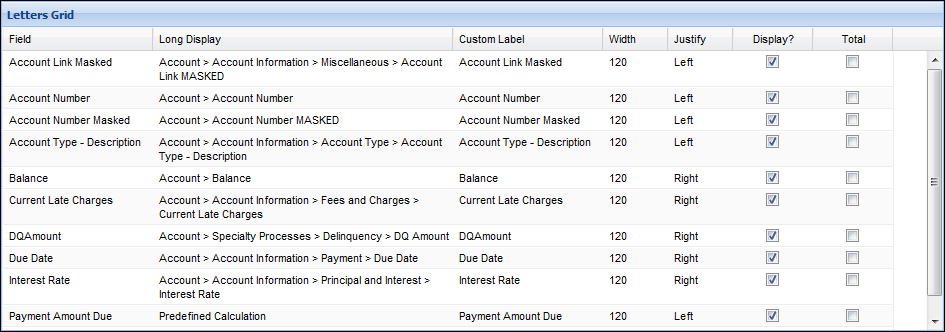
When finished configuring the grid, select the grid and click Insert to add it to the email.

For example, an institution may want to add the DQ Fields for Letter grid but not have the following fields displayed on the grid: Account Number Masked and Interest Rate. They would then uncheck the check mark in the display column. An institution may want the total DQ Amount at the bottom of the grid, and would then select the Total check box.

 |
Once a grid has been added to an email template, no changes can be made to it. If changes need to be made the grid must be deleted from the template, re-configured, and then added back into the template. |
- To Preview the email, enter an account, case or SSN/TIN number and select Preview this Email.
In the right panel of the Design tab, the Subject, Header and Footer sections are available to customize.
Email Component Description Subject Enter a subject that appears when the roles and contacts receive the email.
Header/Footer Enter header and footer text within the respective fields to display in the email.
To create a new email template:
- Click Create.
- The New Email Template screen appears.
- Navigate through the tabs and update the necessary attributes.
- When finished, click Save or Save and Close to save the Email Template and return to the Email Templates page. Click Cancel to return without saving.
To copy an email template:
- Select an email template within the Emails grid.
- Click Copy. The Copy Email Template screen appears.
- Navigate through the tabs and make any required/necessary changes to the attributes.
- When finished, click Save or Save and Close to save the new Email Template. Click Cancel to return to the Email Templates page without saving.
To edit an email template:
- Select an email template within the Emails grid.
- Click Edit. The Edit Email Template screen appears.
- Navigate through the tabs and make any necessary changes to the attributes.
- When finished, click Save or Save and Close to save the Email Template and return to the Email Templates page. Click Cancel to return without saving.
To delete an email template:
- Select an email template within the Emails grid.
- Click Delete.
- A confirmation message appears. Click Yes to delete the Email Template. Click No to return to the Email Templates page without deleting.
 Fields Tab
Fields Tab
